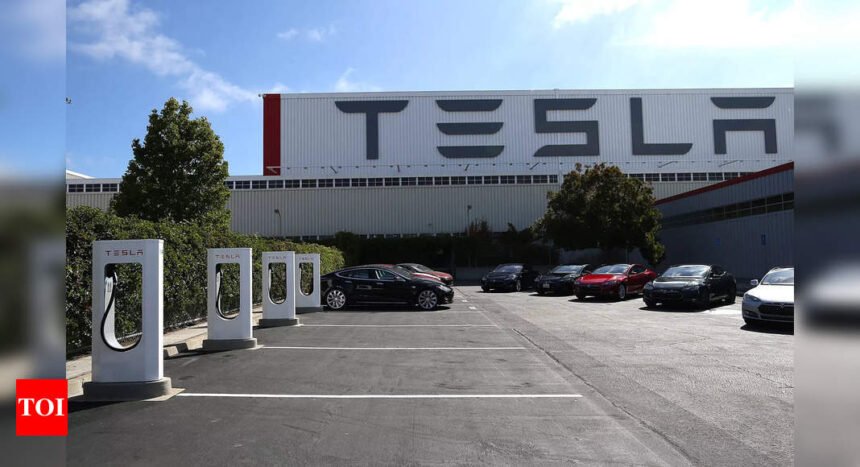Tesla Inc’s disastrous sales report on Tuesday, and traders’ aggressive selling of the stock in the months leading up to it, have the share price plunging toward a critical level for investors.
The electric-vehicle giant’s stock price has sunk more than 33% this year, making it the worst performer in the Nasdaq 100 Index and second worst in the S&P 500 Index.The shares, which traded for around $400 as recently as January 2022, are now at $166 and dropping. So, technical analysts are watching the key $150 level to gauge whether the shares will find the much-needed support.
“Not only is that level where its low from last April comes in, but it is also where we find the bottom of an eight-month downward sloping trend channel,” said Matt Maley, chief market strategist at Miller Tabak + Co. “Therefore, whether it can hold the level or not is going to be extremely important for the stock over the coming days and weeks.”
The shares fell as much as 1.6% by early morning in New York on Wednesday.
Most of Tesla’s recent wipeout reflects concerns about flagging demand for EVs. The company’s dismal first-quarter delivery numbers missed even the lowest Wall Street estimate by a mile, only exacerbating those concerns as it posted its first year-over-year sales drop since the early days of the Covid pandemic. The stock ended Tuesday down 4.9% on the news, making it by far the biggest contributor to the Nasdaq 100’s 0.9% decline.
With this latest leg lower, some on Wall Street say the shares are starting to show signs that the selloff has reached an extreme.
“It feels like lots of bearish sentiment is already baked in and that we are approaching a very good risk-reward entry point,” said Mark Newton, global head of technical strategy at Fundstrat Global Advisors. “Support in the short run lies at March lows of $160.50, and under this would likely drive a move to $152-$155, which would make Tesla quite attractive from a counter-trend perspective to buy dips.”
Even with Tesla’s awful first quarter, the company still carries a lofty market valuation. The stock is priced at around 59 times forward earnings, down from December when it was roughly 66 times.
From here, the question for investors is which way Tesla shares are headed. And that isn’t easy to figure.
Yes, the selloff has been intense, suggesting that it may be time to consider buying in. But the vast disconnect between first-quarter deliveries and analysts’ estimates suggests that Wall Street’s expectations may need to fall even further, which would put the current valuation in question. Profit expectations for 2024 are already down 48% over the past 12 months, while revenue estimates are down 19%.
Tesla’s existential struggle right now is convincing investors that there’s still enough demand for its vehicles to feed the aggressive growth projections that are the basis of its huge market capitalization. At a time when Americans are opting for cheaper cars even among gas-driven offerings, finding consumers willing to pay a premium for an EV is proving difficult, particularly with questions surrounding the charging ecosystem, battery range and used-car values.
That explains why short interest in the shares touched a year-high level of 3.9% of the free float earlier in the week, data from S3 Partners showed.
Though the slowing growth in EVs is a problem for all carmakers, Tesla suffers more acutely because it doesn’t produce gas-powered vehicles. And its enormous market cap — at $531 billion as of Tuesday’s close — leaves very little room for error. General Motors Co, for example, has a market valuation of $52 billion, while Ford Motor Co.’s is $53 billion.
“Based on technicals, we could see support for shares at the April 2023 lows — around $153.75. If the company can’t hold that, then there isn’t much support until the 2022 lows,” said David Mazza, chief strategy officer at Roundhill Investments. “The challenge is that there isn’t a valuation argument to make yet, especially with lower forecasts for the coming quarters.”
The electric-vehicle giant’s stock price has sunk more than 33% this year, making it the worst performer in the Nasdaq 100 Index and second worst in the S&P 500 Index.The shares, which traded for around $400 as recently as January 2022, are now at $166 and dropping. So, technical analysts are watching the key $150 level to gauge whether the shares will find the much-needed support.
“Not only is that level where its low from last April comes in, but it is also where we find the bottom of an eight-month downward sloping trend channel,” said Matt Maley, chief market strategist at Miller Tabak + Co. “Therefore, whether it can hold the level or not is going to be extremely important for the stock over the coming days and weeks.”
The shares fell as much as 1.6% by early morning in New York on Wednesday.
Most of Tesla’s recent wipeout reflects concerns about flagging demand for EVs. The company’s dismal first-quarter delivery numbers missed even the lowest Wall Street estimate by a mile, only exacerbating those concerns as it posted its first year-over-year sales drop since the early days of the Covid pandemic. The stock ended Tuesday down 4.9% on the news, making it by far the biggest contributor to the Nasdaq 100’s 0.9% decline.
With this latest leg lower, some on Wall Street say the shares are starting to show signs that the selloff has reached an extreme.
“It feels like lots of bearish sentiment is already baked in and that we are approaching a very good risk-reward entry point,” said Mark Newton, global head of technical strategy at Fundstrat Global Advisors. “Support in the short run lies at March lows of $160.50, and under this would likely drive a move to $152-$155, which would make Tesla quite attractive from a counter-trend perspective to buy dips.”
Even with Tesla’s awful first quarter, the company still carries a lofty market valuation. The stock is priced at around 59 times forward earnings, down from December when it was roughly 66 times.
From here, the question for investors is which way Tesla shares are headed. And that isn’t easy to figure.
Yes, the selloff has been intense, suggesting that it may be time to consider buying in. But the vast disconnect between first-quarter deliveries and analysts’ estimates suggests that Wall Street’s expectations may need to fall even further, which would put the current valuation in question. Profit expectations for 2024 are already down 48% over the past 12 months, while revenue estimates are down 19%.
Tesla’s existential struggle right now is convincing investors that there’s still enough demand for its vehicles to feed the aggressive growth projections that are the basis of its huge market capitalization. At a time when Americans are opting for cheaper cars even among gas-driven offerings, finding consumers willing to pay a premium for an EV is proving difficult, particularly with questions surrounding the charging ecosystem, battery range and used-car values.
That explains why short interest in the shares touched a year-high level of 3.9% of the free float earlier in the week, data from S3 Partners showed.
Though the slowing growth in EVs is a problem for all carmakers, Tesla suffers more acutely because it doesn’t produce gas-powered vehicles. And its enormous market cap — at $531 billion as of Tuesday’s close — leaves very little room for error. General Motors Co, for example, has a market valuation of $52 billion, while Ford Motor Co.’s is $53 billion.
“Based on technicals, we could see support for shares at the April 2023 lows — around $153.75. If the company can’t hold that, then there isn’t much support until the 2022 lows,” said David Mazza, chief strategy officer at Roundhill Investments. “The challenge is that there isn’t a valuation argument to make yet, especially with lower forecasts for the coming quarters.”









